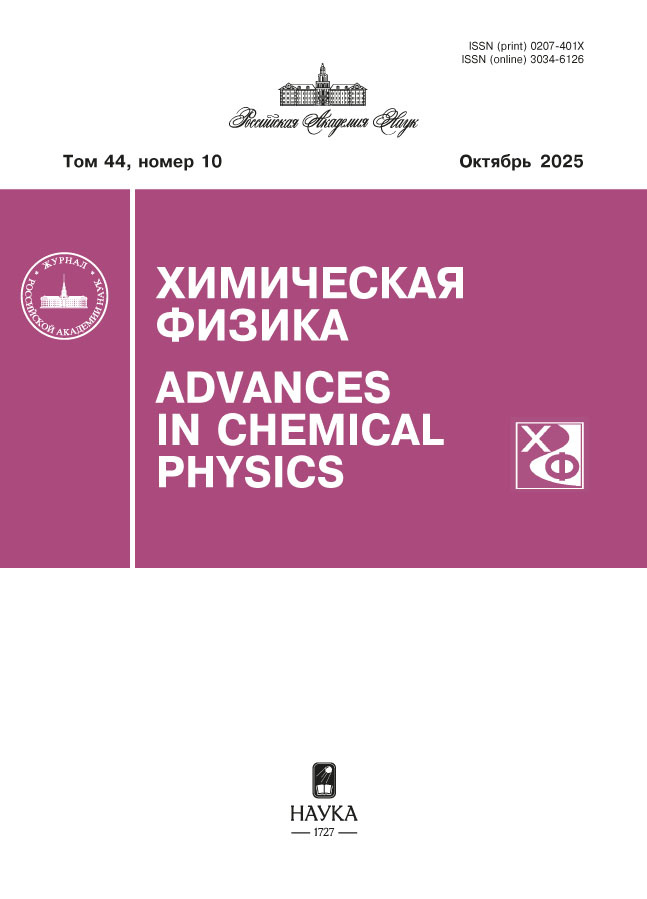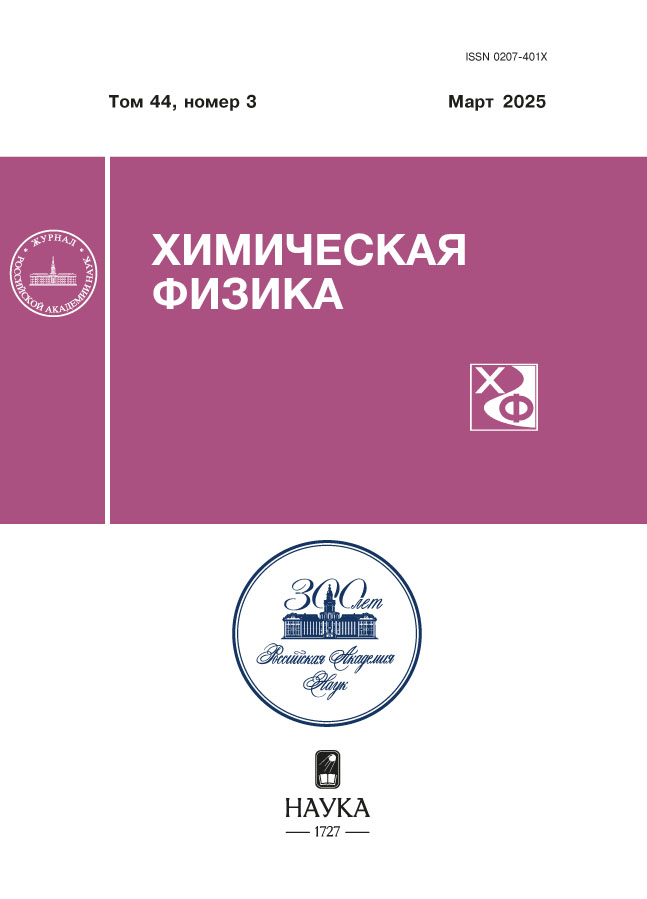Зажигание антрацита лазерным импульсом
- Авторы: Адуев Б.П.1, Нурмухаметов Д.Р.1, Лисков И.Ю.1
-
Учреждения:
- Федеральный исследовательский центр угля и углехимии Сибирского отделения Российской академии наук
- Выпуск: Том 44, № 3 (2025)
- Страницы: 37-48
- Раздел: Горение, взрыв и ударные волны
- URL: https://rjmseer.com/0207-401X/article/view/679467
- DOI: https://doi.org/10.31857/S0207401X25030047
- ID: 679467
Цитировать
Полный текст
Аннотация
Изучено зажигание таблетированных образцов микрочастиц антрацита плотностью ρ = 1 г/см3 и диаметром d ≤ 63 мкм лазерными импульсами. При превышении критической плотности энергии Hcr(1) ≈ 0.15 Дж/см2 во время лазерного импульса происходят оптический пробой поверхности образцов и образование плазменного факела с временем жизни ≥ 5 мкс. Амплитуда свечения плазмы в зависимости от плотности энергии лазерных импульсов описывается в рамках модели оптического пробоя. По спектрам свечения идентифицировано наличие в плазме следующих атомов и молекул: C, C+, Ca+, Fe+, Fe, CN, C2, CO. При плотности H > Hcr(2) в образцах антрацита, как и в образцах каменного угля, происходят инициирование термохимических реакций в объеме микрочастиц, выход и воспламенение летучих веществ и нелетучего остатка в субмиллисекундном временном интервале.
Ключевые слова
Полный текст
Об авторах
Б. П. Адуев
Федеральный исследовательский центр угля и углехимии Сибирского отделения Российской академии наук
Email: lesinko-iuxm@yandex.ru
Институт углехимии и химического материаловедения
Россия, КемеровоД. Р. Нурмухаметов
Федеральный исследовательский центр угля и углехимии Сибирского отделения Российской академии наук
Email: lesinko-iuxm@yandex.ru
Институт углехимии и химического материаловедения
Россия, КемеровоИ. Ю. Лисков
Федеральный исследовательский центр угля и углехимии Сибирского отделения Российской академии наук
Автор, ответственный за переписку.
Email: lesinko-iuxm@yandex.ru
Институт углехимии и химического материаловедения
Россия, КемеровоСписок литературы
- Кислов В.М., Цветков М.В., Зайченко А.Ю. и др. // Хим. физика. 2021. Т. 40. № 9. С. 27. https://doi.org/10.31857/S0207401X21090053
- Paul L.D., Seeley R.R. // Corrosion. 1991. V. 47. № 2. P. 152. https://doi.org/10.5006/1.3585231
- Askarova A.S., Karpenko E.I., Lavrishcheva Y.I. et al.// IEEE Trans. Plasma Sci. 2007. V. 35. P. 1607. https://doi.org/10.1109/TPS.2007.910142
- Masserle V.E., Karpenko E.I., Ustimenko A.B., Lavrichshev O.A. // Fuel Proc. Tech. 2013. V. 107. P. 93. https://doi.org/10.1016/j.fuproc.2012.07.001
- Туктакиев Г.С., Лайко Л.Л. Способ сжигания пылевидного топлива: Патент РФ 2557967 C1 // Б. И. 2015. № 21. С. 11.
- Туктакиев Г.С., Лайко Л.Л. Способ сжигания пылевидного топлива: Патент РФ 2559658 C1 // Б. И. 2015. № 22. С. 11.
- Коротких А.Г., Сорокин И.В., Селихова Е.А., Архипов В.А. // Хим. физика. 2020. Т. 39. № 7. С. 32. https://doi.org/10.31857/S0207401X20070080
- Phuoc T.X., Mathur M.P., Ekmann J.M. // Combust. and Flame. 1993. V. 93. № 1–2. P. 19. https://doi.org/10.1016/0010- 2180(93)90081-D
- Vartak S.D., Gubba S.R., Narayanan K.L. et al. System and method for laser ignition of fuel in a coal-fired burner WO2022/126074 A1. 2022. P. 37.
- Валиулин С.В., Онищук А.А., Палеев Д.Ю. и др. // Хим. физика. 2021. Т. 40. № 4. С. 41. https://doi.org/10.31857/S0207401X21040130
- Taniguchi M., Kobayashi H., Kiyama K., Shimogori Y. // Fuel. 2009. V. 88. № 8. P. 1478.
- Yang Q., Peng Z. // Intern. J. Hydrogen Energy. 2010. V. 35. № 10. P. 4715.
- Манжос Е.В., Коржавин А.А., Козлов Я.В., Намятов И.Г. // Горение и взрыв. 2021. Т. 14. № 3. С. 98. https://doi.org/10.30826/CE21140309
- Chen J.C., Taniguchi M., Narato K., Ito K. // Combust. and Flame. 1994. V. 97. № 1. P. 107. https://doi.org/10.1016/0010- 2180(94)90119-8
- Глова A.Ф., Лысиков A.Ю., Зверев М.М. // Квантовая электрон. 2009. Т. 39. № 6. С. 537. https://doi.org/10.1070/QE2009v039n06ABEH013906
- Taniguchi M., Kobayashi H., Kiyama K., Shimogori Y. // Fuel. 2009. V. 88. № 8. P. 1478. https://doi.org/10.1016/j.fuel.2009.02.009
- Boiko V.M., Volan’skii P., Klimkin V.F. // Combust. Explos. Shock. Waves. 1981. V. 17. № 5. P. 545. https://doi.org/10.1007/BF00798143
- Погодаев В.А. // Физика горения и взрыва. 1984. Т. 20. № 1. С. 51. https://doi.org/10.1007/BF00749917
- Kuzikovskii A.V., Pogodaev V.A. // Combust. Explos. Shock. Waves. 1977. V. 13. № 5. P. 666. https://doi.org/10.1007/BF00742231
- Phuoc T.X., Mathur M.P., Ekmann J.M. // Combust. and Flame. 1993. V. 94. № 4. P. 349. https://doi.org/10.1016/0010-2180(93)90119-Ng
- Aduev B.P., Kraft Y.V., Nurmukhametov D.R., Ismagilov Z.R. // Combust. Sci. Tech. 2024. V. 196. № 2. P. 274. https://doi.org/10.1080/00102202.2022.2075699
- Адуев Б.П., Нурмухаметов Д.Р., Крафт Я.В., Исмагилов З.Р. // Хим. физика. 2022. Т. 41. № 3. С. 13. https://doi.org/10.31857/S0207401X22030025
- Адуев Б.П., Нурмухаметов Д.Р., Нелюбина Н.В. и др. // Хим. физика. 2023. Т. 42. № 3. С. 3. https://doi.org/10.31857/S0207401X23030032
- Адуев Б.П., Нурмухаметов Д.Р., Нелюбина Н.В. и др. // ЖПС. 2021. Т. 88. № 4. С. 582.
- Адуев Б.П., Нурмухаметов Д.Р., Белокуров Г.М. и др. // ХТТ. 2021. № 3. С. 65. https://doi.org/10.31857/S0023117721030026
- Адуев Б.П., Нурмухаметов Д.Р., Лисков И.Ю., Исмагилов З.Р. // Квантовая электрон. 2023. Т. 53. № 5. С. 430.
- Адуев Б.П., Нурмухаметов Д.Р., Волков В.Д. и др. // ЖПС. 2023. Т. 90. № 4. С. 614.
- Левшин Л.В., Салецкий А.М. Люминесценция и ее измерения. М.: Изд-во МГУ, 1989.
- Адуев Б.П., Нурмухаметов Д.Р., Звеков А.А. и др. // ПТЭ. 2015. № 6. С. 60. https://doi.org/10.7868/S0032816215050018
- Делоне Н.Б. Взаимодействие лазерного излучения с веществом. Курс лекций. М.: Наука, 1989.
- NIST. Standard Reference Database 78. https://dx.doi.org/10.18434/T4W30F
- Camacho J.J., Santos M., Diaz L., Poyato J.M.L. // J. Phys. D. 2018. V. 41. Issue 21. P. 215206. https://doi.org/10.1088/0022-3727/41/21/215206
- Пирс Р., Гейдон А. Отождествление молекулярных спектров. M.: Изд-во иностр. лит., 1949.
- LIFBASE. Database and spectral simulation for diatomic molecules (v. 1.6); https://www.sri.com/platform/lifbase-spectroscopy-tool/
Дополнительные файлы

















